You are using an out of date browser. It may not display this or other websites correctly.
You should upgrade or use an alternative browser.
You should upgrade or use an alternative browser.
Photos Navies Of All Nations
- Thread starter BravoZulu
- Start date
-
- Tags
- hms saumarez
- Joined
- Feb 20, 2020
- Messages
- 6,142
- Points
- 309
USS New Ironsides and five monitor-class warships engaging Forts Wagner and Gregg in Charleston harbor, S.C., in what is one of the world's first combat action photographs, taken in (September 5-6(?) 1863.Haas & Peale
George Cook, half stereo of Federal ironclads firing on Fort Moultrie, Sept 8, 1863 – The Valentine, Richmond, Va.
- Joined
- Apr 2, 2017
- Messages
- 38,640
- Points
- 463
RN:
HMS Torch, Ringdove and Goldfinch in Sutherland Dock, Cockatoo Island, Sydney c. 1897-9

HMS Torch was an Alert-class sloop of the Royal Navy launched in 1894, she spent most of her life on the Australia Station, taking part in the native uprising on the Island of Wala, Vanuatu in July 1914. In August 1914 she joined the New Zealand Division of the Pacific Station. In 1917 she was renamed HMS Firebrand and became a training ship in New Zealand.
HMS Ringdove and Goldfinch were Redbreast-class gunboats. Ringdove would become a tender to HMS Vernon (Training Ship) after her active service until being broken up in 1927. Goldfinch became a survey vessel in the Mediterranean, but her poor condition during a refit in 1906 led to her being sold to be broken up in 1907.
HMS Torch, Ringdove and Goldfinch in Sutherland Dock, Cockatoo Island, Sydney c. 1897-9

HMS Torch was an Alert-class sloop of the Royal Navy launched in 1894, she spent most of her life on the Australia Station, taking part in the native uprising on the Island of Wala, Vanuatu in July 1914. In August 1914 she joined the New Zealand Division of the Pacific Station. In 1917 she was renamed HMS Firebrand and became a training ship in New Zealand.
HMS Ringdove and Goldfinch were Redbreast-class gunboats. Ringdove would become a tender to HMS Vernon (Training Ship) after her active service until being broken up in 1927. Goldfinch became a survey vessel in the Mediterranean, but her poor condition during a refit in 1906 led to her being sold to be broken up in 1907.
- Joined
- Apr 2, 2017
- Messages
- 38,640
- Points
- 463
USN:
USS Constitution under escort on the Delaware River, Philadelphia after her restoration, c. 1931

January 3, 1940: Hornet CV-8 under construction at Newport News Shipbuilding & Drydock Co., Newport News, Virginia

USS Arkansas (BB-33) off New York City, Sept 23, 1942

Escort carrier USS Kasaan Bay (CVE-69) off Gould Island in Narragansett Bay, Rhode Island (USA), 16 September 1944.
Kasaan Bay was laid down initially as ACV-69, a US Maritime Commission S4-S2-BB3 escort carrier, in May 1943. She was completed as CVE-69 in October 1943 and was commissioned in December 1943. Following a short shakedown she was assigned to Pacific Fleet aircraft and personnel ferry and replenishment duty, commencing in January 1944. On 8 January 1944, the carrier departed San Francisco with a cargo of planes and passengers for Pearl Harbor. Upon returning to San Diego she sailed for Norfolk, arriving on 28 February for overhaul and operations along the East Coast. On 28 May, she departed New York in company of Tulagi and Mission Bay with a cargo of planes for Casablanca, returning to New York on 17 June with 342 survivors of Block Island, which was torpedoed on 29 May.
The escort carrier departed Quonset Point, Rhode Island on 30 June and arrived Oran on 10 July. Throughout July, she engaged in ASW patrol and flight operations in the Mediterranean before rehearsing for the assault on Southern France. Kasaan Bay departed Malta on 12 August, and 3 days later arrived in the invasion area off the French Riviera. In one of the few instances in which F6Fs operated in combat from a CVE, F6F-5s and -5Ns assigned to the 24-plane squadrons VF-74 aboard Kasaan Bay and VOF-1 aboard Tulagi carried out a variety of missions in support of the landings and fighting inland. The CVEs conducted operations in concert with British escort carriers. Limited opportunities for air-to-air combat presented themselves but Kasaan Bay pilots shot down two German aircraft. She completed her assignment on 30 August and departed Oran, Algeria on 6 September, arriving Norfolk 12 days later.
Following a cruise carrying planes to Casablanca in late October, Kasaan Bay was assigned to the Pacific Fleet and arrived San Diego on 2 January 1945. During January she sailed to Pearl Harbor, Guam, and Ulithi with planes and replacements for other ships of the Fast Carrier Task Force.
The escort carrier returned Pearl Harbor on 14 February and immediately commenced training operations for air groups and replacement pilots. Kasaan Bay continued this duty until early June when she was assigned ASW patrols in the shipping lanes between the Marshall and Mariana Islands protecting the fleet's supply line during its final assault on Japan's defenses.
USS Constitution under escort on the Delaware River, Philadelphia after her restoration, c. 1931

January 3, 1940: Hornet CV-8 under construction at Newport News Shipbuilding & Drydock Co., Newport News, Virginia

USS Arkansas (BB-33) off New York City, Sept 23, 1942

Escort carrier USS Kasaan Bay (CVE-69) off Gould Island in Narragansett Bay, Rhode Island (USA), 16 September 1944.

Kasaan Bay was laid down initially as ACV-69, a US Maritime Commission S4-S2-BB3 escort carrier, in May 1943. She was completed as CVE-69 in October 1943 and was commissioned in December 1943. Following a short shakedown she was assigned to Pacific Fleet aircraft and personnel ferry and replenishment duty, commencing in January 1944. On 8 January 1944, the carrier departed San Francisco with a cargo of planes and passengers for Pearl Harbor. Upon returning to San Diego she sailed for Norfolk, arriving on 28 February for overhaul and operations along the East Coast. On 28 May, she departed New York in company of Tulagi and Mission Bay with a cargo of planes for Casablanca, returning to New York on 17 June with 342 survivors of Block Island, which was torpedoed on 29 May.
The escort carrier departed Quonset Point, Rhode Island on 30 June and arrived Oran on 10 July. Throughout July, she engaged in ASW patrol and flight operations in the Mediterranean before rehearsing for the assault on Southern France. Kasaan Bay departed Malta on 12 August, and 3 days later arrived in the invasion area off the French Riviera. In one of the few instances in which F6Fs operated in combat from a CVE, F6F-5s and -5Ns assigned to the 24-plane squadrons VF-74 aboard Kasaan Bay and VOF-1 aboard Tulagi carried out a variety of missions in support of the landings and fighting inland. The CVEs conducted operations in concert with British escort carriers. Limited opportunities for air-to-air combat presented themselves but Kasaan Bay pilots shot down two German aircraft. She completed her assignment on 30 August and departed Oran, Algeria on 6 September, arriving Norfolk 12 days later.
Following a cruise carrying planes to Casablanca in late October, Kasaan Bay was assigned to the Pacific Fleet and arrived San Diego on 2 January 1945. During January she sailed to Pearl Harbor, Guam, and Ulithi with planes and replacements for other ships of the Fast Carrier Task Force.
The escort carrier returned Pearl Harbor on 14 February and immediately commenced training operations for air groups and replacement pilots. Kasaan Bay continued this duty until early June when she was assigned ASW patrols in the shipping lanes between the Marshall and Mariana Islands protecting the fleet's supply line during its final assault on Japan's defenses.
- Joined
- Apr 2, 2017
- Messages
- 38,640
- Points
- 463
Italy:
The capsized wreck of the battleship Leonardo da Vinci in Taranto's Mar Grande, 1916

She capsized in Taranto harbor, in 11 meters (36 ft) of water, after an internal magazine explosion on the night of 2/3 August 1916 while loading ammunition. Casualties included 21 officers and 227 enlisted men. The subsequent investigation blamed Austro-Hungarian saboteurs, but unstable propellant may well have been responsible.
The capsized wreck of the battleship Leonardo da Vinci in Taranto's Mar Grande, 1916

She capsized in Taranto harbor, in 11 meters (36 ft) of water, after an internal magazine explosion on the night of 2/3 August 1916 while loading ammunition. Casualties included 21 officers and 227 enlisted men. The subsequent investigation blamed Austro-Hungarian saboteurs, but unstable propellant may well have been responsible.
- Joined
- Apr 2, 2017
- Messages
- 38,640
- Points
- 463
Italy:
Destroyer Lampo aground after action with Royal Navy destroyers of the 14th Flotilla on the early hours of 16 April 1941, when she was escorting an Axis convoy with German troops to Tripoli.
The raised hull of the incomplete battleship Impero in the Bacino San Marco at Venice, being towed to be scrapped, 1949

"Raised" because the incomplete hull, still a long way to go for completion when it had been captured by German troops on 9 September 1943, after having been used by tests by the Germans and going through Allied bombardments, had been found sunk in the waters off Trieste. With the added complication of the Yugoslav authorities claiming the wreck as "war prize", the ship had been raised, then sunk once more in a different position inside the harbour, and finally raised once and for all in 1947. The hull was then towed to Venice, and deliberately beached on a shallow, waiting to be scrapped.
Destroyer Lampo aground after action with Royal Navy destroyers of the 14th Flotilla on the early hours of 16 April 1941, when she was escorting an Axis convoy with German troops to Tripoli.

The raised hull of the incomplete battleship Impero in the Bacino San Marco at Venice, being towed to be scrapped, 1949

"Raised" because the incomplete hull, still a long way to go for completion when it had been captured by German troops on 9 September 1943, after having been used by tests by the Germans and going through Allied bombardments, had been found sunk in the waters off Trieste. With the added complication of the Yugoslav authorities claiming the wreck as "war prize", the ship had been raised, then sunk once more in a different position inside the harbour, and finally raised once and for all in 1947. The hull was then towed to Venice, and deliberately beached on a shallow, waiting to be scrapped.
- Joined
- Apr 2, 2017
- Messages
- 38,640
- Points
- 463
Sweden:
HSwMS Äran, Sept 9, 1944

HSwMS Äran (Swedish language: "Honour") was a Swedish first class coastal defence ship (Pansarskepp). She was used briefly during World War II in the Baltic sea first in the Ålands eskader later in the Karlskrona eskader. This type of ship is commonly known as a coastal defence battleship. Having entered service on 7 September 1902, she was stricken on 13 June 1947. The hulk sank while under tow in 1968.
HSwMS Äran, Sept 9, 1944

HSwMS Äran (Swedish language: "Honour") was a Swedish first class coastal defence ship (Pansarskepp). She was used briefly during World War II in the Baltic sea first in the Ålands eskader later in the Karlskrona eskader. This type of ship is commonly known as a coastal defence battleship. Having entered service on 7 September 1902, she was stricken on 13 June 1947. The hulk sank while under tow in 1968.
- Joined
- Apr 2, 2017
- Messages
- 38,640
- Points
- 463
France:
Ironclad Dévastation at anchor in Algiers, Mediterranean Squadron, c. 1893

View from Formidable of the French squadron sailing in formation near Sfax, c. 1893. Ships from left to right are Davout, Cécille, A.l Duperré, Neptune, Hoche, Redoutable, Courbet with Formidable being the ship the photo was taken from

Ironclad Dévastation at anchor in Algiers, Mediterranean Squadron, c. 1893

View from Formidable of the French squadron sailing in formation near Sfax, c. 1893. Ships from left to right are Davout, Cécille, A.l Duperré, Neptune, Hoche, Redoutable, Courbet with Formidable being the ship the photo was taken from

- Joined
- Apr 2, 2017
- Messages
- 38,640
- Points
- 463
Canada:
110 years ago, HMCS Rainbow became the first ship of the Naval Service of Canada

HMCS Rainbow was an Apollo-class protected cruiser built for Great Britain's Royal Navy as HMS Rainbow entering service in 1892. Rainbow saw time in Asian waters before being placed in reserve in 1909. In 1910 the cruiser was transferred to the Royal Canadian Navy for service on the west coast.
HMCS Niobe became the second ship of the Naval Service of Canada for service on the east coast

HMS Niobe was a ship of the Diadem class of protected cruisers in the Royal Navy. She served in the Boer War and was then given to Canada as the second ship of the newly created Naval Service of Canada as HMCS Niobe.
110 years ago, HMCS Rainbow became the first ship of the Naval Service of Canada

HMCS Rainbow was an Apollo-class protected cruiser built for Great Britain's Royal Navy as HMS Rainbow entering service in 1892. Rainbow saw time in Asian waters before being placed in reserve in 1909. In 1910 the cruiser was transferred to the Royal Canadian Navy for service on the west coast.
HMCS Niobe became the second ship of the Naval Service of Canada for service on the east coast

HMS Niobe was a ship of the Diadem class of protected cruisers in the Royal Navy. She served in the Boer War and was then given to Canada as the second ship of the newly created Naval Service of Canada as HMCS Niobe.
- Joined
- Apr 2, 2017
- Messages
- 38,640
- Points
- 463
Philippines & PRC:
'David vs Goliath' A Philippine Coast Guard "Boracay-class" Fast Patrol Boat, and a China Coast Guard "Type-818" Cutter, on patrol in the surrounding waters of Scarborough Shoal, one of the highly disputed islands in the South China Sea (West Philippine Sea), 2019

'David vs Goliath' A Philippine Coast Guard "Boracay-class" Fast Patrol Boat, and a China Coast Guard "Type-818" Cutter, on patrol in the surrounding waters of Scarborough Shoal, one of the highly disputed islands in the South China Sea (West Philippine Sea), 2019

- Joined
- Apr 2, 2017
- Messages
- 38,640
- Points
- 463
France:
The crew of the battleship Richelieu manning the rails as the U.S. aircraft carrier USS Saratoga (CV-3) ended operations with the Royal Navy's Eastern Fleet in the Indian Ocean, 18 May 1944

The crew of the battleship Richelieu manning the rails as the U.S. aircraft carrier USS Saratoga (CV-3) ended operations with the Royal Navy's Eastern Fleet in the Indian Ocean, 18 May 1944

- Joined
- Apr 2, 2017
- Messages
- 38,640
- Points
- 463
USN:
USS Concord (CL-10) underway in 1932.

USS Concord (CL-10) was an Omaha-class light cruiser, originally classified as a scout cruiser, of the United States Navy. She was the fourth Navy ship named for the town of Concord, Massachusetts, the site of the first battle of the American Revolution. She spent the first nine years of her career in the Atlantic as part of the Scouting Force. Concord transferred to the Pacific in 1932 and spent the rest of her career, except for the winter of 1938–1939, stationed there. Her home port moved to Pearl Harbor in April 1940, but escaped the attack on Pearl Harbor because she was in San Diego for an overhaul
USS Concord (CL-10) off Balboa, Panama Canal Zone, on 6 January 1943
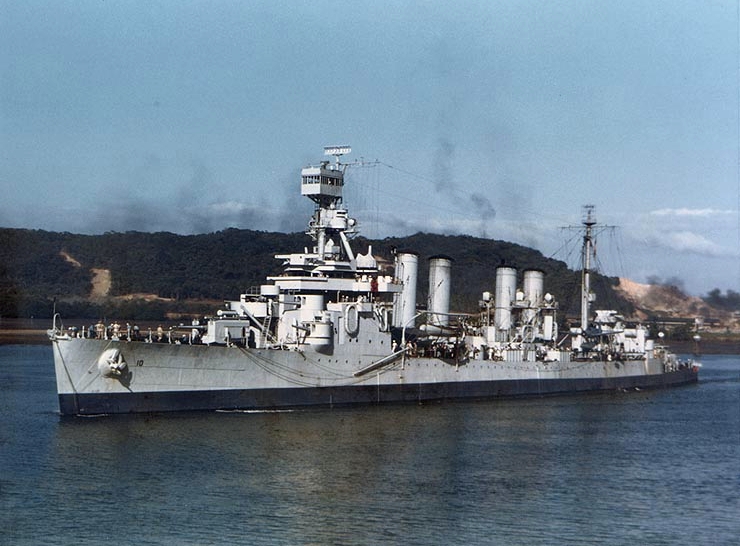
USS Concord crew member Harold Clifford DeLong and other crew member on USS Concord at sea.

USS Coral Sea (CVB-43) underway on 17 March 1949. Coral Sea, with assigned Carrier Air Group 2 (CVG-2), was deployed to the Mediterranean Sea from 3 May to 26 September 1949.

USS Concord (CL-10) underway in 1932.

USS Concord (CL-10) was an Omaha-class light cruiser, originally classified as a scout cruiser, of the United States Navy. She was the fourth Navy ship named for the town of Concord, Massachusetts, the site of the first battle of the American Revolution. She spent the first nine years of her career in the Atlantic as part of the Scouting Force. Concord transferred to the Pacific in 1932 and spent the rest of her career, except for the winter of 1938–1939, stationed there. Her home port moved to Pearl Harbor in April 1940, but escaped the attack on Pearl Harbor because she was in San Diego for an overhaul
USS Concord (CL-10) off Balboa, Panama Canal Zone, on 6 January 1943

USS Concord crew member Harold Clifford DeLong and other crew member on USS Concord at sea.

USS Coral Sea (CVB-43) underway on 17 March 1949. Coral Sea, with assigned Carrier Air Group 2 (CVG-2), was deployed to the Mediterranean Sea from 3 May to 26 September 1949.

- Joined
- Apr 2, 2017
- Messages
- 38,640
- Points
- 463
RN:
HMS REPULSE, painted in a dazzle camouflage scheme, while escorting the last troop convoy to reach Singapore. The ship was sunk a few days later with great loss of life on 10 December 1941 by Japanese torpedoes. The sinking, along with that of HMS PRINCE OF WALES, was an appalling blow to British prestige in the Far East.
HMS REPULSE, painted in a dazzle camouflage scheme, while escorting the last troop convoy to reach Singapore. The ship was sunk a few days later with great loss of life on 10 December 1941 by Japanese torpedoes. The sinking, along with that of HMS PRINCE OF WALES, was an appalling blow to British prestige in the Far East.

Similar threads
- Replies
- 2
- Views
- 7K
- Replies
- 0
- Views
- 1K
- Replies
- 0
- Views
- 1K
- Replies
- 15
- Views
- 4K
- Replies
- 583
- Views
- 67K
- Sticky
- Replies
- 758
- Views
- 78K






